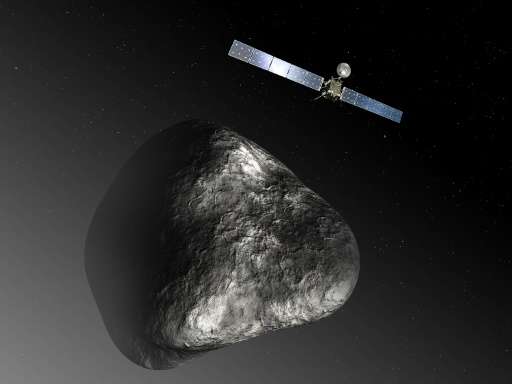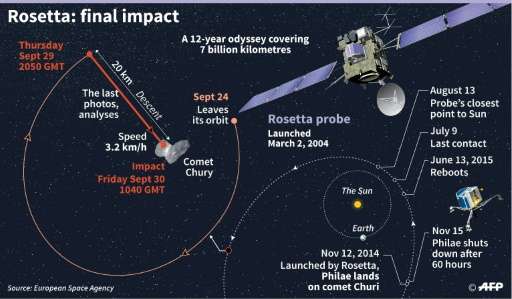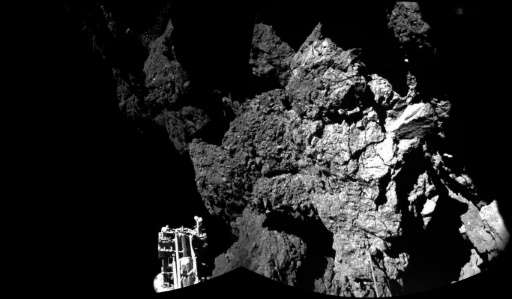Rosetta: beginning of the end for Europe's comet craft

Europe was poised Thursday to crashland its Rosetta spacecraft on a comet it has stalked for over two years, joining robot lander Philae on the cosmic wanderer's icy surface in a final suicide mission.
A 12-year odyssey to probe the origins of our Solar System will conclude with a last-gasp spurt of science-gathering after Rosetta is instructed at 2050 GMT to quit the orbit of Comet 67P/Churyumov-Gerasimenko.
The space explorer will descend over a leisurely 14 hours, from an altitude of 19 kilometres (12-miles), sniffing the comet's gassy coma, or halo, measuring its temperature and gravity, and taking pictures from closer than ever before.
"It's all go," Rosetta project scientist Matt Taylor told AFP at the European Space Agency's mission control centre in Darmstadt.
"We're all very excited. In the final descent, we will get into a region that we have never sampled before. We've never been below two kilometres, and that region is where the coma, the comet atmosphere, becomes alive, it's where it goes from being an ice to a gas."
Rosetta will receive the command to crash at a distance of 720 million kilometres (450 million miles) from Earth, with the comet zipping through space at a speed of over 14 kilometres (nine miles) per second.
A "controlled impact" at human walking speed, about 90 cm (35 inches) per second, is scheduled for 1040 GMT on Friday—give or take 20 minutes.
Confirmation of the mission's end is expected in Darmstadt some 40 minutes later, when Rosetta's delayed signal vanishes from ground controllers' computer screens.
"It's mixed emotions," Taylor said of the impending end.
While it will all be over for mission controllers, scientists will be analysing the information gleaned for "years if not decades" to come.

Puzzle pieces
"We've only just started to get an understanding of what the data is telling us, putting together the pieces of the puzzle," said Taylor.
"We've got this massive puzzle, all the pieces are everywhere, and we need to put them together."
The first-ever mission to orbit and land on a comet was approved in 1993 to explore the origins and evolution of our Solar System—of which comets are thought to contain primordial material preserved in a dark space deep freeze.
Rosetta and lander probe Philae travelled more than six billion kilometres (3.7 billion miles) over 10 years to reach 67P in August 2014.
Philae was launched to the comet surface in November of that year, bouncing several times, then gathering 60 hours of on-site data which it sent home before entering standby mode.
Insights gleaned from the 1.4-billion-euro ($1.5-billion) mission have shown that comets crashing into an early Earth may well have brought amino acids, the building blocks of life.
Comets of 67P's type, however, certainly did not bring water, scientists have concluded.
Rosetta's comet is currently speeding away from the Sun on its near seven-year elongated orbit, which means the craft's solar panels are catching fewer battery-replenishing rays.
Rather than just letting it fade away, scientists opted to end the mission on a high by taking measures from distances too close to risk under usual operating conditions.
Rosetta was never designed to land.
"Tonight is the beginning of the end," said Taylor. "That is what we're waiting for—we're waiting for this manoeuvre to begin that final phase."
A highlight of the final hours will be a one-off chance to peer into mysterious pits dotting the landscape for hints as to what the comet's interior might look like.
Rosetta was programmed to switch off on impact, to make sure its signals do not interfere with any future space missions.
"After Rosetta has touched down, it will not be possible to collect or return any additional data," the ESA said.

Rosetta: What did Europe's comet mission uncover?
Europe's Rosetta spacecraft, due to switch off Friday after a 12-year odyssey, carried eleven scientific instruments to sniff and photograph a comet from all angles.
After arriving in orbit around comet 67P/Churyumov-Gerasimenko, it launched Philae, a separate lander, which itself had 10 hi-tech gadgets, including cameras, X-ray scans, radio wave probes and a drill that never deployed.
Together, the robot explorers have advanced our understanding of comets—of which there are billions—believed to be leftovers from the birth of our Solar System some 4.6 billion years ago.
"Nobody had any idea comets can be so weird until Rosetta got there," said Fabio Favata of the European Space Agency's (ESA) robotic exploration directorate.
What the mission found:
Shapely...
Expecting to encounter something roughly the shape of an American football, scientists were flabbergasted to observe through Rosetta's cameras that 67P resembled a rubber bath duck with a distinct "body" and "head", and a crack through its "neck".
Some scientists have since postulated that this shape was not created by erosion, but a low-velocity impact billions of years ago between two objects which fused.
This all suggests the comet was formed in a young, outer part of our Solar System that was much less densely packed with bodies than previously thought.
If not, 67P "is so fragile it should have been clobbered by something else and broken apart," ESA senior science advisor Mark McCaughrean told AFP.
This affects our understanding of planetary formation, thought to have happened when ice and dust debris, swirling around in a proto-planetary disk around an infant Sun, collided and stuck together, growing bigger and bigger over time.
...but hard
The comet's surface was another surprise.
It was less "fluffy" and much harder than expected, which contributed to Philae bouncing several times after its harpoons failed to fire on landing.
The comet had much less water ice than thought, was littered with pebbles and rocks ranging in size from a few centimetres (inches) across to five metres (18 feet), and pocked with deep craters. The surface is rendered super-dark and non-reflective by a thin layer of dust.
Surprise!
Scientists were astonished to find oxygen molecules in the gassy halo around the comet, and said they appeared to be older than our Solar System.
Scientific models had previously calculated that oxygen as a molecular compound on its own would not have existed at the time the comet was formed, as it would have bonded with other elements like hydrogen.
So, how the comet got its oxygen remains a mystery.
Life's beginnings
67P has organic molecules, many different ones—including amino acids, which are the building blocks of life as we know it.
This discovery supports the hypothesis that comets may very well have helped spark life on Earth by delivering organic materials when they slammed into a young planet that was basically molten iron.
No H2O
Water, on the other hand, is unlikely to have come from comets of 67P's type, the mission found.
The water on Rosetta is of a very different "flavour" than that on our planet, with three times more deuterium, a heavy hydrogen isotope.
Stinker
Analysing the comet's chemical signature, Rosetta scientists concluded it probably smells like a noxious mix of rotten eggs, horse urine, alcohol and bitter almonds.
"If you could smell the comet, you would probably wish that you hadn't," the ESA team said at the time.
No attraction
Philae's magnetometer found that, surprisingly, 67P has no measurable magnetic field—throwing into question another key theory on the formation of solar system bodies.
It implied that magnetism played no part in debris in the early Solar System clumping together to form planets, comets, asteroids and moons.
Not over yet
Scientists expect that the data extracted by Philae and Rosetta will keep them busy for decades to come.
"The metaphor I used at the beginning, was Rosetta would be the key that would unlock the treasure chest to the secrets of the Solar System. I think... we found the key, it's on the floor and it's in pieces. We need to assemble the key first before we can unlock the treasure chest," said McCaughrean.
Rosetta: Comet mission with an Egyptian flavour
When Europe's comet chaser was launched in 2004, it boasted the name of the famous Rosetta stone, which had helped decipher hieroglyphics, the mysterious written language of the ancient Egyptians.
The moniker was chosen because Rosetta, the spacecraft, would also be a decoder—unravelling the mysteries of comets, which are clusters of ice and dust left over from the formation of the Solar System some 4.6 billion years ago.
Scientists believe comets shed light on how life on Earth came about.
In more than two years orbiting Comet 67P/Churyumov-Gerasimenko, which included placing the first ever lander on a comet surface, Rosetta has lived up to its cryptographer epithet, though many more secrets remain to be teased from the data unearthed.
The name also set the trend for naming aspects of the mission after Egyptian place names, gods or kings.
Here are some other names:
AGILKIA
The site on the comet where Rosetta's Philae lander was meant to touch down in November 2014. The spot was named for an island on the Nile which became the new home of Pharaonic temples transferred from Philae, another island, when the Aswan Dam threatened to flood the complex.
The lander Philae bounced several times when its harpoons failed to fire, and instead of Agilkia, settled in a dark crevice in a different location, later named ABYDOS after an ancient Egyptian city.
DEIR EL-MEDINA
A "pit" on the comet surface near the spot where Rosetta is to make a "controlled impact" on Friday.
According to the European Space Agency, the feature resembles a pit in an Egyptian town that was home to workers building pharaonic tombs in the Valley of the Kings. It became a dumping ground for discarded pottery with inscriptions recording aspects of daily life.
Just as the clay shards yielded insight into working class ancient Egyptians, so scientists hope that peering deep into Deir el-Medina as Rosetta descends will reveal the insides of a comet.
HAPI
The "neck" that divides the two lobes of the plastic bath duck-shaped comet into a distinct "head" and larger "body".
"Hapi is the Nile god, and we figured that he should separate the lobes in the same way that the Nile splits Egypt into the eastern and western side," explains the European Space Agency's Rosetta blog.
IMHOTEP
A region on the larger comet lobes, Imhotep shares the name of a master architect and pyramid-builder who lived about 5,000 years ago and was deified after his death.
The other 18 comet regions are also named after Egyptian deities, including Aten, Aker, Ash (god of oases), Babi (god of virility), and Seth (god of the desert).
"We wanted to adhere to the ancient Egyptian theme of the mission," the ESA blog states. "Luckily, ancient Egyptians had so many deities in their long history that made this an easy decision.
"Moreover, many of the names were catchy, easy to remember—and more importantly, easy to pronounce."
OSIRIS
An acronym for Optical, Spectroscopic and Infrared Remote Imaging System, the camera onboard Rosetta, Osiris was also the name of the ancient Egyptian god of the underworld.
PHILAE
The washing machine-sized comet lander got its name from the Nile island in southern Egypt where in 1815 an obelisk was found which was key to understanding the Rosetta stone, discovered in 1799, with carved inscriptions in hieroglyphs and Greek.
PTOLEMY
A gas "sniffer" onboard the Philae lander shares a name with an Egyptian king whose name appeared on the Rosetta stone.
The comet itself is named after the two Ukrainian astronomers, Klim Churyumov and Svetlana Gerasimenko, credited with discovering it in 1969. "P" refers to a periodic comet, which takes fewer than 200 years to orbit the Sun, while "67" is its number on a list of similar comets discovered.
© 2016 AFP



















